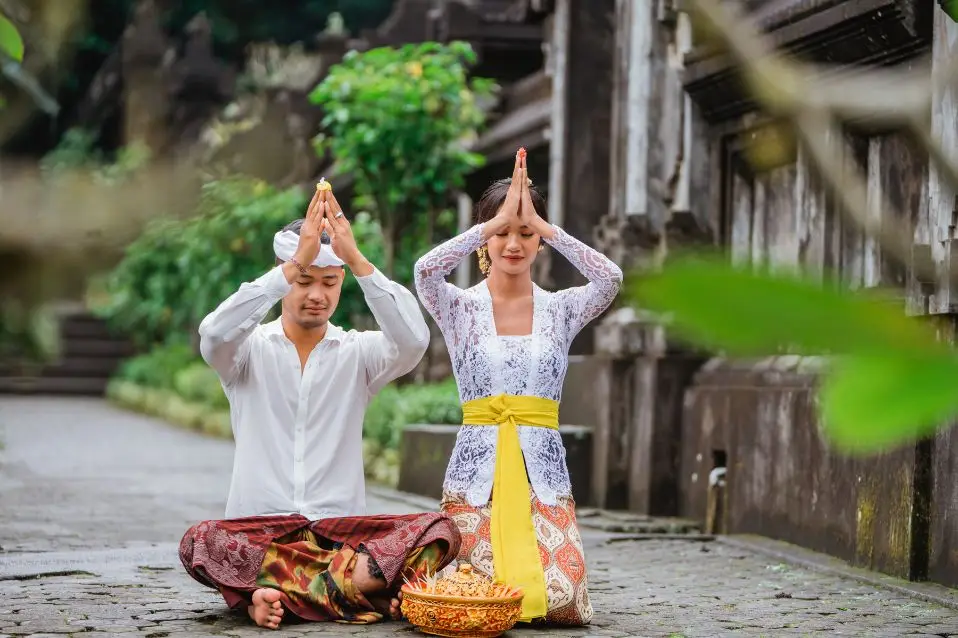흔히 '신들의 섬'으로 불리는 발리는 아름다운 해변과 활기찬 문화로 유명한 열대 낙원일 뿐만이 아닙니다. 발리는 일상의 리듬이 종교적 관습과 의식과 얽혀 있는 영성에 깊이 뿌리를 둔 곳이기도 합니다. 섬 곳곳에 있는 사원은 예배, 문화 행사, 커뮤니티 모임을 위한 신성한 공간으로 활용되고 있습니다. 이 블로그 포스팅에서는 발리의 가장 상징적인 사원 몇 곳을 둘러보고 발리의 정신적 삶을 정의하는 다양한 종교적 휴일에 대해 자세히 알아보세요.
Bali’s Most Iconic Temples
1. Pura Besakih (Mother Temple)
Pura Besakih, also known as the Mother Temple, is Bali’s most important temple complex. Situated on the slopes of Mount Agung, Bali’s highest volcano, this temple is a grand structure that comprises 23 separate temples, with the largest and most important being Pura Penataran Agung. Pura Besakih is a significant site for Hindu worship and is often the center of major religious festivals. The temple’s elevated location offers breathtaking views of the surrounding landscape, making it a must-visit for both spiritual seekers and photographers.
2. Pura Ulun Danu Bratan
Located on the shores of Lake Bratan in Bedugul, Pura Ulun Danu Bratan is one of Bali’s most picturesque temples. This water temple is dedicated to Dewi Danu, the goddess of lakes and rivers, and is revered for its serene beauty and spiritual significance. The temple complex features traditional Balinese architectural styles, and its reflection on the calm lake waters creates a stunning visual that is often captured in photographs. The temple is especially significant for the local agricultural community, who come to pray for abundant crops and sufficient rainfall.
3. Pura Tanah Lot
Pura Tanah Lot is perhaps the most iconic and photographed temple in Bali. Perched on a rocky outcrop just offshore, it appears to float on the ocean during high tide. This sea temple is dedicated to the sea gods and is a crucial part of Balinese mythology and spirituality. Visitors flock to Tanah Lot, especially at sunset, to witness the temple silhouetted against the vibrant evening sky. The temple is not only a place of worship but also a cultural landmark that embodies the harmony between nature and spirituality in Balinese culture.
4. Pura Luhur Uluwatu
Perched dramatically on a cliff 70 meters above the Indian Ocean, Pura Luhur Uluwatu is one of Bali’s six key directional temples. This temple is dedicated to the spirits of the sea and is believed to protect Bali from evil sea spirits. Pura Uluwatu is also famous for its Kecak dance performances, which are held daily at sunset against the backdrop of the temple and the ocean. The dance narrates the Ramayana epic and is a unique cultural experience that captivates visitors.
5. Pura Tirta Empul
Pura Tirta Empul, located near Ubud, is one of Bali’s most important water temples. The temple is renowned for its holy spring water, which Balinese Hindus believe has purifying properties. Visitors can participate in a traditional purification ritual by immersing themselves in the temple’s sacred pools. The temple complex also includes a number of shrines and statues, and the water from the spring is believed to bring good fortune and spiritual cleansing.
Bali’s Religious Holidays and Festivals
Bali’s religious holidays are vibrant celebrations of faith, culture, and community. These events are integral to the island’s Hindu traditions and offer visitors a unique glimpse into Balinese life.
1. Nyepi (Balinese Day of Silence)
Nyepi, the Balinese New Year, is one of the most significant and unique religious holidays in Bali. Unlike most New Year celebrations, Nyepi is marked by a day of complete silence, meditation, and self-reflection. The entire island comes to a standstill—no flights, no work, no noise, and even the lights are turned off. The day before Nyepi, large effigies of demons (Ogoh-Ogoh) are paraded through the streets and then burned in a ritual to drive away evil spirits. Nyepi is a powerful and introspective day, offering a profound experience of Bali’s spiritual depth.
2. Galungan and Kuningan
Galungan and Kuningan are two of the most important festivals in the Balinese Hindu calendar, celebrating the victory of dharma (good) over adharma (evil). Galungan marks the time when ancestral spirits visit the earth, and Balinese families honor their ancestors with offerings and prayers at temples and home shrines. The streets are decorated with penjor—tall bamboo poles adorned with offerings. Kuningan, which occurs ten days after Galungan, marks the end of the festive period and the return of the ancestral spirits to their heavenly abodes. These festivals are filled with rituals, dances, and feasts, showcasing Bali’s rich cultural heritage.
3. Saraswati
Saraswati Day is dedicated to Saraswati, the goddess of knowledge, music, art, and wisdom. On this day, books and scriptures are blessed, and students, teachers, and scholars offer prayers for wisdom and knowledge. Balinese Hindus visit temples to seek blessings for their studies and creative endeavors. The day emphasizes the importance of learning and is celebrated with prayers and offerings, particularly in schools and libraries.
4. Odalan
Odalan is a temple anniversary celebration, occurring every 210 days according to the Balinese pawukon calendar. Each temple in Bali has its own Odalan, and the celebrations can last several days, featuring elaborate rituals, gamelan music, traditional dances, and vibrant processions. Odalan is a time for communal worship and festivities, and it’s an excellent opportunity for visitors to witness Balinese spirituality and cultural expression firsthand.
5. Tumpek Celebrations
Tumpek is a series of holy days dedicated to different aspects of life. There are several Tumpek days throughout the year, each focusing on different elements such as animals (Tumpek Kandang), plants (Tumpek Uduh), and technology (Tumpek Landep). On these days, Balinese people make offerings and prayers to express gratitude and seek blessings for these vital aspects of life. Tumpek ceremonies highlight the Balinese philosophy of Tri Hita Karana, which emphasizes harmony between humans, nature, and the divine.
Exploring Bali’s temples and experiencing its religious holidays offer a deep insight into the island’s soul. These sacred sites and festivals are not just tourist attractions; they are living traditions that embody the values, beliefs, and spiritual practices of the Balinese people. Whether you’re witnessing the majestic Pura Besakih or observing the silent reflection of Nyepi, Bali invites you to connect with its spiritual essence and experience a culture that is as rich as it is ancient.




